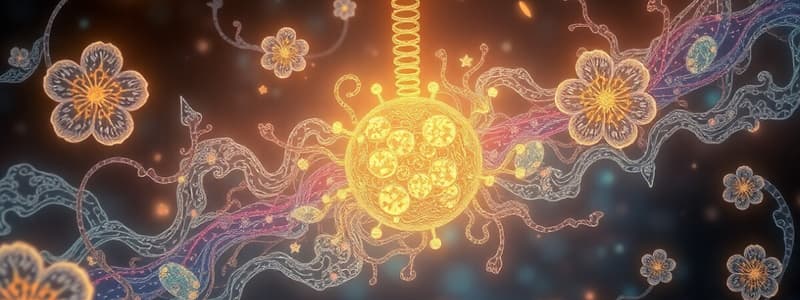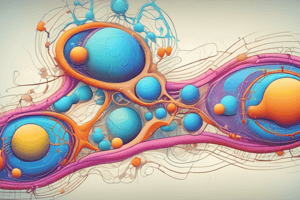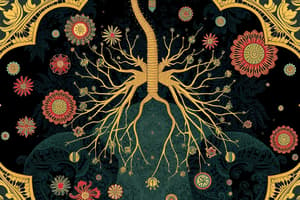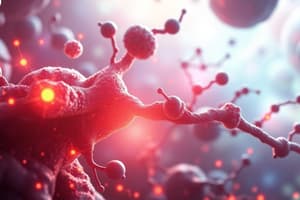Podcast
Questions and Answers
What facilitates the return of phosphate to the mitochondrion?
What facilitates the return of phosphate to the mitochondrion?
- Phosphate carrier/translocase (correct)
- Proton pump
- ATP synthase
- NADH transporter
What is the theoretical maximum ATP yield from one molecule of glucose?
What is the theoretical maximum ATP yield from one molecule of glucose?
- 26 or 28 ATP
- 34 or 36 ATP
- 20 or 22 ATP
- 30 or 32 ATP (correct)
How many protons are pumped as a result of the oxidation of one NADH molecule?
How many protons are pumped as a result of the oxidation of one NADH molecule?
- 6 protons
- 8 protons
- 12 protons
- 10 protons (correct)
What drives the synthesis of approximately 2.5 ATP molecules per NADH oxidized?
What drives the synthesis of approximately 2.5 ATP molecules per NADH oxidized?
How many ATP are synthesized from one FADH2 molecule?
How many ATP are synthesized from one FADH2 molecule?
What is the energy change ($ riangle G'$) for the reaction involving NADH and O2?
What is the energy change ($ riangle G'$) for the reaction involving NADH and O2?
What is the role of 3-phosphoglycerol dehydrogenase in the cytosol?
What is the role of 3-phosphoglycerol dehydrogenase in the cytosol?
During glycolysis, how many NADH are produced per glucose molecule?
During glycolysis, how many NADH are produced per glucose molecule?
What role does the proton gradient play in the mitochondrial function?
What role does the proton gradient play in the mitochondrial function?
Which enzyme is responsible for the phosphorylation of fructose in muscle tissue?
Which enzyme is responsible for the phosphorylation of fructose in muscle tissue?
In the liver, how is fructose-1-phosphate split?
In the liver, how is fructose-1-phosphate split?
What is one effect of reactive oxygen species (ROS) on cellular components?
What is one effect of reactive oxygen species (ROS) on cellular components?
What happens to glycerol-3-phosphate in the mitochondria?
What happens to glycerol-3-phosphate in the mitochondria?
During the oxidation of glycerol-3-phosphate to DHAP, which electron carrier is produced?
During the oxidation of glycerol-3-phosphate to DHAP, which electron carrier is produced?
Which reaction involves ferrous iron and hydrogen peroxide leading to the formation of hydroxyl radicals?
Which reaction involves ferrous iron and hydrogen peroxide leading to the formation of hydroxyl radicals?
Which category of antioxidants functions by binding free radicals?
Which category of antioxidants functions by binding free radicals?
Which of the following tissues primarily carries out fructose metabolism?
Which of the following tissues primarily carries out fructose metabolism?
Which of the following is NOT classified as an antioxidant?
Which of the following is NOT classified as an antioxidant?
What is the significance of the glycerol phosphate shuttle?
What is the significance of the glycerol phosphate shuttle?
What product results from the superoxide dismutase reaction?
What product results from the superoxide dismutase reaction?
What reduces NAD+ to NADH during the conversion of DHAP to glycerol-3-phosphate?
What reduces NAD+ to NADH during the conversion of DHAP to glycerol-3-phosphate?
Which antioxidants are well-known for scavenging free radicals?
Which antioxidants are well-known for scavenging free radicals?
How does glutathione function in the antioxidant defense?
How does glutathione function in the antioxidant defense?
What role do buffering ions like iron and copper play in oxidative stress?
What role do buffering ions like iron and copper play in oxidative stress?
What allows Complex II to maintain some ATP production when Complex I is inhibited?
What allows Complex II to maintain some ATP production when Complex I is inhibited?
What is the primary function of the F0 portion of ATP synthase?
What is the primary function of the F0 portion of ATP synthase?
What happens to the c subunit ring when protons bind to aspartic acid residues?
What happens to the c subunit ring when protons bind to aspartic acid residues?
What occurs during the Open State (O) in ATP synthesis?
What occurs during the Open State (O) in ATP synthesis?
How does the rotation of the c subunit ring contribute to ATP synthesis?
How does the rotation of the c subunit ring contribute to ATP synthesis?
What occurs during the transition from the L state to the T state in ATP synthesis?
What occurs during the transition from the L state to the T state in ATP synthesis?
Which enzyme is responsible for converting oxaloacetate to malate in the cytosol during the malate-aspartate shuttle?
Which enzyme is responsible for converting oxaloacetate to malate in the cytosol during the malate-aspartate shuttle?
Which subunits make up the F1 portion of ATP synthase?
Which subunits make up the F1 portion of ATP synthase?
What is the main function of the malate-aspartate shuttle?
What is the main function of the malate-aspartate shuttle?
What is the significance of Complex II's ability to function independently of Complex I?
What is the significance of Complex II's ability to function independently of Complex I?
Which component of ATP synthase is primarily involved in proton binding?
Which component of ATP synthase is primarily involved in proton binding?
How many ATP molecules are synthesized during each full rotation of the F1 component?
How many ATP molecules are synthesized during each full rotation of the F1 component?
What role does aspartate aminotransferase play in the malate-aspartate shuttle?
What role does aspartate aminotransferase play in the malate-aspartate shuttle?
Which antiporter is involved in transporting malate into the mitochondrial matrix?
Which antiporter is involved in transporting malate into the mitochondrial matrix?
What is the primary tissue where the malate-aspartate shuttle operates?
What is the primary tissue where the malate-aspartate shuttle operates?
In the glycerol phosphate shuttle, what is the primary role of this mechanism?
In the glycerol phosphate shuttle, what is the primary role of this mechanism?
What is the primary function of catalase in the body?
What is the primary function of catalase in the body?
What is the primary role of uncoupling protein 1 (UCP-1) in nonshivering thermogenesis?
What is the primary role of uncoupling protein 1 (UCP-1) in nonshivering thermogenesis?
Which factor initiates the activation of UCP-1 in response to cold temperatures?
Which factor initiates the activation of UCP-1 in response to cold temperatures?
What type of animals predominantly utilize nonshivering thermogenesis to maintain body temperature?
What type of animals predominantly utilize nonshivering thermogenesis to maintain body temperature?
What is the consequence of UCP-1 allowing protons to flow back into the mitochondrial matrix?
What is the consequence of UCP-1 allowing protons to flow back into the mitochondrial matrix?
Which physiological context is particularly dependent on nonshivering thermogenesis?
Which physiological context is particularly dependent on nonshivering thermogenesis?
What is the primary reaction outcome of peroxidase activity?
What is the primary reaction outcome of peroxidase activity?
In nonshivering thermogenesis, the energy from nutrient oxidation is primarily released as:
In nonshivering thermogenesis, the energy from nutrient oxidation is primarily released as:
Flashcards
Loose State (L) in ATP Synthase
Loose State (L) in ATP Synthase
A state in ATP synthase where ADP and inorganic phosphate (Pi) are loosely bound, allowing for energy input to drive ATP synthesis.
Tense State (T) in ATP Synthase
Tense State (T) in ATP Synthase
A state in ATP synthase where ADP and Pi are tightly bound, leading to the formation of ATP.
ATP Synthesis by ATP Synthase
ATP Synthesis by ATP Synthase
The process of generating ATP by the enzyme ATP synthase, involving the movement of protons across the mitochondrial membrane.
Malate-Aspartate Shuttle
Malate-Aspartate Shuttle
Signup and view all the flashcards
Malate Dehydrogenase
Malate Dehydrogenase
Signup and view all the flashcards
Aspartate Aminotransferase
Aspartate Aminotransferase
Signup and view all the flashcards
Glycerol Phosphate Shuttle
Glycerol Phosphate Shuttle
Signup and view all the flashcards
Electron transport chain in the Glycerol Phosphate Shuttle
Electron transport chain in the Glycerol Phosphate Shuttle
Signup and view all the flashcards
Complex II's Resilience
Complex II's Resilience
Signup and view all the flashcards
What is ATP Synthase?
What is ATP Synthase?
Signup and view all the flashcards
F0 Portion Role
F0 Portion Role
Signup and view all the flashcards
F1 Portion Role
F1 Portion Role
Signup and view all the flashcards
Proton Translocation
Proton Translocation
Signup and view all the flashcards
Rotation and ATP Synthesis
Rotation and ATP Synthesis
Signup and view all the flashcards
ATP Synthesis Process
ATP Synthesis Process
Signup and view all the flashcards
Open, Loose, and Tight States
Open, Loose, and Tight States
Signup and view all the flashcards
DNA Damage by ROS
DNA Damage by ROS
Signup and view all the flashcards
Lipid Peroxidation by ROS
Lipid Peroxidation by ROS
Signup and view all the flashcards
Protein Oxidation by ROS
Protein Oxidation by ROS
Signup and view all the flashcards
Enzyme Deactivation by ROS
Enzyme Deactivation by ROS
Signup and view all the flashcards
Fenton Reaction
Fenton Reaction
Signup and view all the flashcards
Haber-Weiss Reaction
Haber-Weiss Reaction
Signup and view all the flashcards
Antioxidants
Antioxidants
Signup and view all the flashcards
Enzymes as Antioxidants
Enzymes as Antioxidants
Signup and view all the flashcards
What is the first step in the glycerol phosphate shuttle?
What is the first step in the glycerol phosphate shuttle?
Signup and view all the flashcards
After the first reaction in the glycerol phosphate shuttle, where does glycerol 3-phosphate travel?
After the first reaction in the glycerol phosphate shuttle, where does glycerol 3-phosphate travel?
Signup and view all the flashcards
What happens to glycerol 3-phosphate once it reaches the mitochondria?
What happens to glycerol 3-phosphate once it reaches the mitochondria?
Signup and view all the flashcards
What is the final step in the glycerol phosphate shuttle?
What is the final step in the glycerol phosphate shuttle?
Signup and view all the flashcards
What is fructose metabolism?
What is fructose metabolism?
Signup and view all the flashcards
How is fructose metabolized in muscle tissue?
How is fructose metabolized in muscle tissue?
Signup and view all the flashcards
How is fructose metabolized in liver tissue?
How is fructose metabolized in liver tissue?
Signup and view all the flashcards
What happens to the products of fructose-1-phosphate aldolase in the liver?
What happens to the products of fructose-1-phosphate aldolase in the liver?
Signup and view all the flashcards
Theoretical ATP Yield from Glucose Oxidation
Theoretical ATP Yield from Glucose Oxidation
Signup and view all the flashcards
Shuttle Systems for Electron Transport
Shuttle Systems for Electron Transport
Signup and view all the flashcards
Electron Transport Chain in Mitochondria
Electron Transport Chain in Mitochondria
Signup and view all the flashcards
Phosphate Transport into the Mitochondria
Phosphate Transport into the Mitochondria
Signup and view all the flashcards
ATP, ADP, and Phosphate Transport
ATP, ADP, and Phosphate Transport
Signup and view all the flashcards
Nonshivering Thermogenesis
Nonshivering Thermogenesis
Signup and view all the flashcards
Uncoupling Protein 1 (UCP-1)
Uncoupling Protein 1 (UCP-1)
Signup and view all the flashcards
Proton Uncoupling
Proton Uncoupling
Signup and view all the flashcards
Heat Production
Heat Production
Signup and view all the flashcards
Norepinephrine
Norepinephrine
Signup and view all the flashcards
Fatty Acids
Fatty Acids
Signup and view all the flashcards
Thermoregulation
Thermoregulation
Signup and view all the flashcards
Study Notes
Electron Transport Chain Overview
- The Electron Transport Chain (ETC) is vital for cellular respiration, located in the inner mitochondrial membrane.
- It drives ATP production through oxidative phosphorylation.
- The process starts with electrons from reduced substrates (NADH and FADH2), generated in glycolysis and the citric acid cycle.
- These electrons are transferred through protein complexes (I, II, III, IV) and electron carriers, ultimately reducing oxygen to form water.
- Energy released during electron flow pumps protons (H+) from the mitochondrial matrix to the intermembrane space, creating an electrochemical gradient.
- This gradient provides the energy for ATP synthase to convert ADP and inorganic phosphate (Pi) to ATP.
Oxidative Fuel Production
- The ETC is part of a larger process, including glycolysis and the citric acid cycle.
- These pathways supply the electron carriers (NADH and FADH2) for the ETC.
- NADH produces approximately 2.5 ATP molecules.
- FADH2 produces approximately 1.5 ATP molecules.
- Proton pumping coupled with electron flow establishes the essential proton gradient for ATP synthesis.
Mechanism of Proton Pumping
- The ETC involves four main complexes.
- Complex I accepts electrons from NADH, pumping 4 H+ ions into the intermembrane space.
- Complex II accepts electrons from FADH2 but does not pump protons.
- Complex III transfers electrons via the Q cycle, pumping 4 H+ across the membrane.
- Complex IV receives electrons from cytochrome c, reducing O2 to H2O and pumping 2 H+.
- The total protons pumped contribute to the proton-motive force that drives ATP synthesis.
Role of ATP Synthase
- ATP synthase utilizes the electrochemical potential from the proton gradient.
- As protons flow back into the mitochondrial matrix through ATP synthase, energy is released, converting ADP and inorganic phosphate (Pi) into ATP.
- This process is essential for cellular energy production.
Summary of Electron Transport Chain Process
- Electrons from NADH and FADH2 are transferred through the ETC.
- The transfer process pumps protons into the intermembrane space, creating a gradient.
- Oxygen acts as the final electron acceptor, forming water.
- The proton gradient drives ATP synthesis via ATP synthase.
Oxidative Phosphorylation
- Oxidative phosphorylation is a crucial metabolic process occurring in the mitochondria.
- It produces ATP through the electron transport chain (ETC) and chemiosmosis.
- The process uses energy from electron transfer from electron donors, such as NADH and FADH2, to oxygen (final electron acceptor).
- The overall reaction is NADH + 1/2O2 + H+ → NAD+ + H2O.
- Energy release from NADH-to-O2 transfer drives ATP synthesis.
Role of Electron Carriers
- Electron carriers (NADH and FADH2) play a critical role in oxidative phosphorylation.
- NADH produces approximately 2.5 ATP.
- FADH2 produces approximately 1.5 ATP.
- These carriers donate electrons to the ETC, passing them through protein complexes in the inner mitochondrial membrane.
Complex I: NADH Dehydrogenase
- Complex I, also known as NADH dehydrogenase, plays a key role in the electron transport chain (ETC).
- NADH is oxidized to NAD+ releasing two electrons (2e-).
- Electrons are transferred through Flavin mononucleotide (FMN) and Iron-sulfur clusters.
- Four protons (4H+) are pumped into the intermembrane space per two electrons transferred.
- Coenzyme Q (CoQ) receives transferred electrons and is reduced to QH2 (ubiquinol).
Complex II: Succinate Dehydrogenase
- Complex II, also known as succinate dehydrogenase, is part of the electron transport chain (ETC).
- It catalyzes the conversion of succinate to fumarate in the citric acid cycle.
- FAD is reduced to FADH2, releasing two electrons (2e-).
- Electrons are transferred through Fe-S clusters to CoQ, which reduces to QH2.
- Complex II does not pump protons (H+) across the inner mitochondrial membrane.
Complex III: Q-Cytochrome C Oxidoreductase
- Complex III, also known as Q-cytochrome c oxidoreductase, is involved in the electron transport chain (ETC).
- QH2 binds to heme bL, then heme bH, where it is oxidized to Q, releasing 2 protons (2H+) and two electrons (2e-).
- Electrons are transferred through iron-sulfur (Fe-S) clusters to cytochrome c, which then carries electrons to complex IV.
- Complex III pumps 4 protons into the intermembrane space during the Q cycle.
Complex IV: Cytochrome C Oxidase
- Complex IV (cytochrome c oxidase) is the final complex in the electron transport chain (ETC).
- It receives electrons from cytochrome c, requiring four cytochrome c molecules to transfer a total of 4 electrons.
- Electrons bind with copper subunits.
- Four protons (4H+) and O2 are used to reduce oxygen to form two water molecules (2H2O).
- Complex IV pumps two protons (2H+) into the intermembrane space per two electrons it transfers.
Summary of Proton Pumping
- Complex I pumps 4 protons.
- Complex II does not pump protons.
- Complex III pumps 4 protons.
- Complex IV pumps 2 protons.
- The proton-motive force generated by these complexes drives ATP synthesis by ATP synthase.
ATP Synthase Mechanism
- ATP synthase is a crucial enzyme for ATP production.
- It consists of F0 and F1 portions.
- The F0 portion is embedded in the inner mitochondrial membrane and is responsible for proton translocation.
- The F1 portion protrudes into the mitochondrial matrix and is the site of ATP synthesis.
- Protons flow back into the matrix through the F0 portion, driving the rotation of the c ring and the F1 portion, which catalyzes ATP synthesis from ADP and inorganic phosphate (Pi).
Shuttle Mechanisms
- Malate-Aspartate Shuttle: Electrons from cytosolic NADH are transferred to the mitochondrial matrix via malate and aspartate.
- Glycerol-3-Phosphate Shuttle: Transfers electrons from cytosolic NADH to FAD in the mitochondrial membrane, generating FADH2.
Mitochondrial Dysfunction: MERRF
- Myoclonic Epilepsy with Ragged Red Fibers (MERRF) is a mitochondrial disorder.
- It is maternally inherited and results in disruptions in the synthesis of proteins involved in oxidative phosphorylation.
- Clinical features may include; myoclonic seizures, hearing loss, lactic acidosis, exercise intolerance, and poor night vision.
- The results are due to accumulations of inactive mitochondria, leading to impaired ATP production.
ATP-ADP Translocation
- The ATP-ADP translocator facilitates the exchange of ATP and ADP across the inner mitochondrial membrane.
- ATP, in a net charge of -4, is exported from the matrix.
- ADP, with a net charge of -3, is imported into the matrix.
- This process involves Adenine nucleotide translocase as a carrier.
- Proton gradient drives the transport.
Role of Uncoupling Proteins
- Uncoupling protein 1 (UCP-1), primarily located in brown adipose tissue, allows protons (H+) to flow back into the mitochondrial matrix without passing through ATP synthase.
- The process utilizes these protons for heat production instead of ATP synthesis.
Reduction Potentials
- Reduction potential measures the tendency of a chemical species to acquire electrons.
- A higher reduction potential indicates a greater tendency for reduction.
- Reduction potentials are used to predict which species will act as electron donors and acceptors in chemical reactions.
Theoretical ATP Yield
- Electron transfer from NADH generates approximately 2.5 ATPs.
- Electron transfer from FADH2 generates approximately 1.5 ATPs.
- Glycolysis, pyruvate oxidation, and the citric acid cycle contribute to the overall ATP yield.
- The theoretical maximum ATP yield from glucose oxidation is 30-32 ATPs
Reactive Oxygen Species (ROS) Formation
- ROS are formed through homolytic cleavage, resulting in unpaired electrons.
- Key reactions for ROS formation include the Fenton and Haber-Weiss reactions.
- ROS can damage DNA, lipids, proteins, and enzymes, leading to various cellular effects.
Antioxidants
- Antioxidants neutralize the harmful effects of ROS.
- Enzymes such as superoxide dismutase, catalase, and peroxidase contribute to this process.
- Other antioxidants include vitamins C and E, buffering ions (like Fe and Cu), and specific proteins.
Nonshivering Thermogenesis
- Nonshivering thermogenesis is a metabolic process in warm-blooded animals.
- It generates heat by using energy from nutrient oxidation to release heat instead of converting to ATP.
- Uncoupling protein 1 (UCP-1) plays a crucial role in the process, found primarily in brown adipose tissue.
- Activation typically in response to cold environments.
Fructose Metabolism
- Fructose metabolism is primarily in the liver and muscle tissue.
- In muscles, fructose is phosphorylated into fructose-6-phosphate and enters glycolysis.
- In the liver, fructose is phosphorylated to fructose-1-phosphate.
- Fructose-1-phosphate is spilt into dihydroxyacetone phosphate and glyceraldehyde.
- Glyceraldehyde and dihydroxyacetone phosphate can enter glycolysis.
Studying That Suits You
Use AI to generate personalized quizzes and flashcards to suit your learning preferences.
Related Documents
Description
Test your knowledge on cellular respiration, ATP synthesis, and the biochemistry of mitochondria. This quiz covers key concepts including the roles of NADH, FADH2, and the proton gradient. Explore how energy is produced at the cellular level!





